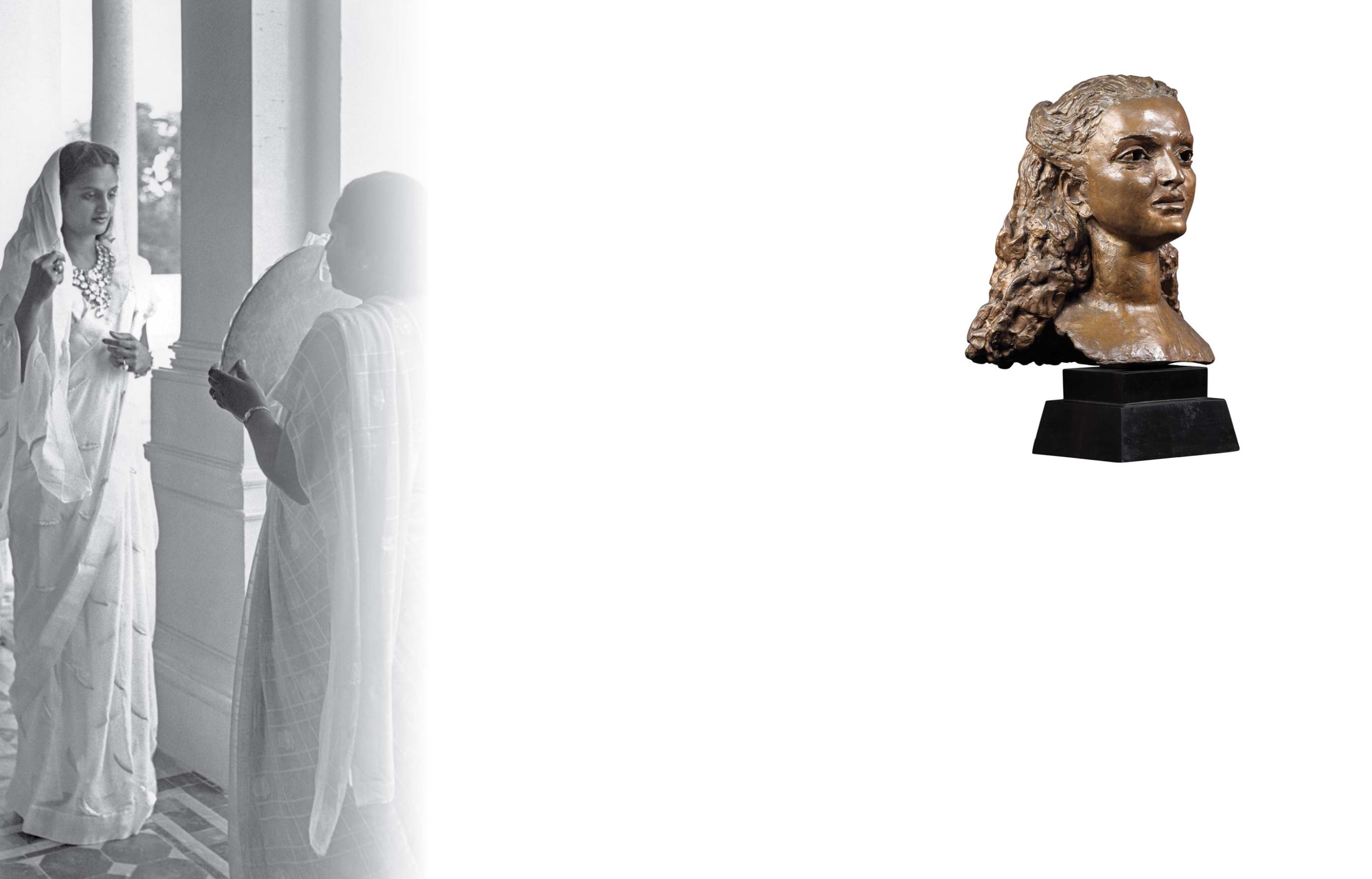

206
Saffronart | Evening Sale
207
One of the earliest sculptors to look outside Europe for
inspiration, Sir Jacob Epstein was known primarily for his
portrait sculptures and monuments. Born in 1880 in New
York, he forayed into sculpting in 1899 under George Grey
Bernard. He went to Paris in 1902, studying at the École des
Beaux‒Arts, and the Académie Julian. Three years later, he
moved to London and became a British citizen. Epstein
came into contact with leading contemporary artists in
the following decade, including Picasso, Brancusi and
Modigliani. His representational sculptures stood out as
particularly remarkable in a time of Cubism and abstraction.
After 1916, Epstein lived and worked in London for the rest
of his life, exhibiting frequently at the Leicester Galleries. His
sculptures include those of Rabindranath Tagore (1926),
Albert Einstein (1933), Jawaharlal Nehru (1948), and the
Maharaja and Maharani of Baroda, among others. The
present lot, most likely commissioned by the Royal Family
of Baroda, successfully captures Maharani Sita Devi’s regal
expression and poise, through her calm, steady gaze, arched
eyebrows, and pursed lips. Epstein was owed £ 2,000 for
the work he had done for her. (“Letter from Jacob Epstein
to Peggy Jean,” 5 October 1952, © The Estate of Sir Jacob
Epstein,
Tate Archive
,
online)
According to Epstein, “Intellectually it [sculpture] requires
a far greater effort of concentration to visualize a work in
the round... in carving there is absolute finality about every
movement. It is impossible to rub out and begin again.”
Epstein used ‘direct carving’, where “the actual process
of carving suggests the final form rather than a carefully
worked out preliminary model.”
( tate.org,
online) In 1953,
he was honoured with a retrospective exhibition at the Tate
Gallery in London, by the Arts Council, and knighted the
following year. His major public sculptures are to be found
in London, Oxford and Coventry in England, and in Wales.
78
SIR JACOB EPSTEIN
(1880 ‒ 1959)
Portrait of the Maharanee of Baroda
Inscribed ‘EPSTEIN’ (on the reverse)
Bronze
Height: 13.5 in (34.5 cm)
Width: 12.5 in (32 cm)
Depth: 9.5 in (24 cm)
Rs 6,00,000 ‒ 8,00,000
$ 9,095 ‒ 12,125
PROVENANCE:
Maharaja of Baroda (1908‒1968)
Thence by descent to Prince Gaekwar of Baroda
(1930‒1988)
Christie’s, London, 3 March 1988, lot 138
Private Collection, India
MAHARANI SITA DEVI
OF BARODA
Sita Devi was the daughter of the Maharaja of Pithampuram.
As one of the most flamboyant and controversial figures
of her time, she “redefined societal roles by leading a
gregarious and thoroughly unconventional life on entirely
her own terms.” (Abhishek Poddar and Nathaniel Gaskell
eds.,
Maharanis: Women of Royal India
,
Ahmedabad: Mapin
Publishing in association with Tasveer Arts, 2015, p. 79)
Sita Devi was initially married to the Zamindar of Vuyyur.
When she met Maharaja Pratapsinh Gaekwad of Baroda,
also married, at the Madras Race Course, they both fell in
love and sought a way around the religious and legal norms
to marry each other. “While Sita Devi converted to Islam
in order to divorce her first husband and reconverted to
Hinduism to marry the Maharaja, he and his lawyers cleverly
argued against the Britishwho sought to squash thewedding
on the basis of the Baroda state law against bigamy passed
by Sayaji Rao III, by noticing that state laws did not apply
to the ruler, only to his subjects. The couple made a splash
in salons in Europe, and at a time when most maharanis
photographed usually had their heads demurely covered,
Sita Devi was often seen posing with her hair thrown back
so as to best showcase her jewellery, or smoking a cigarette
at social events in a holder—also studded with rubies.”
(Poddar and Gaskell eds., p. 79)
Following World War II, the couple travelled to Europe.
They built a resplendent mansion in Monaco, a French
principality that had survived the onslaught of war, and
settled there. Copious amounts of treasures from the
Baroda state were transferred to their new home. When
India attained independence in 1947, the princely states
acceded to the Indian Union, and several valuable pieces
from the royal treasuries had to, by law, be transferred to the
treasury of the Government of India. As they attempted to
sort the personal jewels and state‒owned treasures of the
Gaekwad of Baroda, Maharani Sita Devi transferred many
jewels into her own name. She refashioned several of her
jewels into new pieces designed by the world’s leading
jewellers, including Van Cleef & Arpels and Harry Winston.
Her glamorous lifestyle faded in the 1950s, when she and
Maharaja Pratapsinh Gaekwad divorced. Maharani Sita Devi
passed away in 1986 in Neuilly‒sur‒Seine, France.
Sita Devi, Baroda, Gujarat, 1948
© Henri Cartier-Bresson/Magnum Photos


















